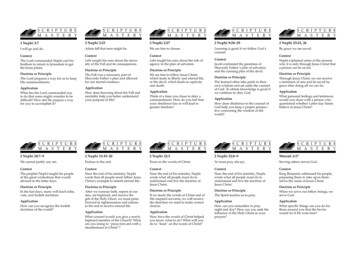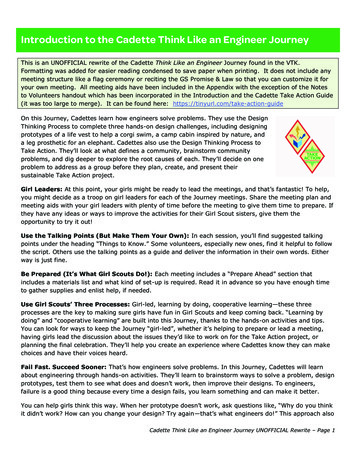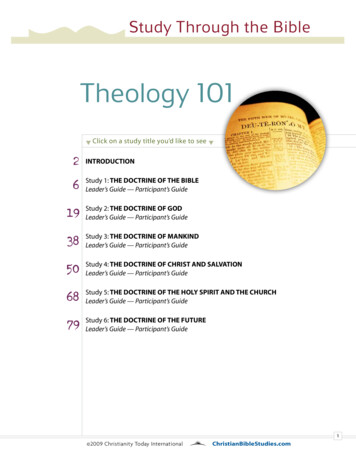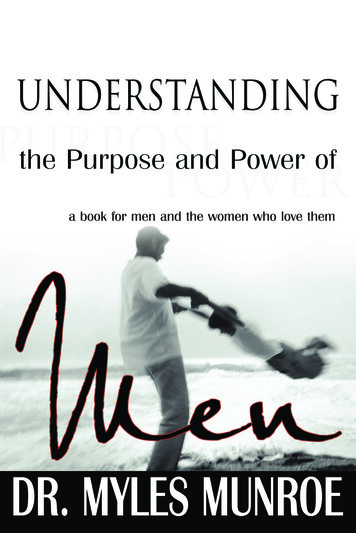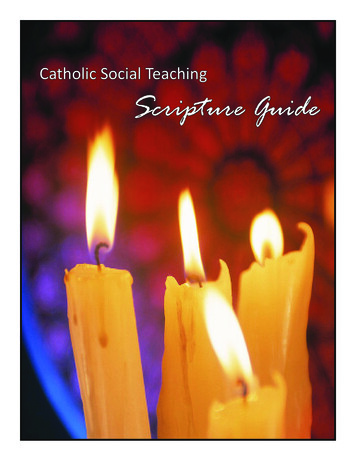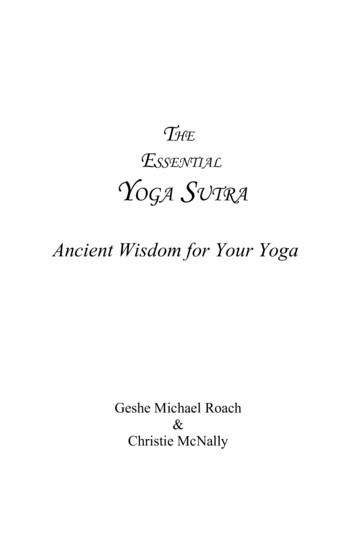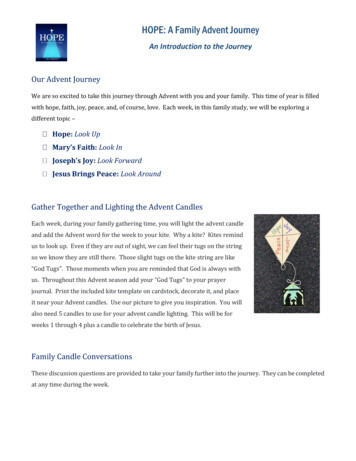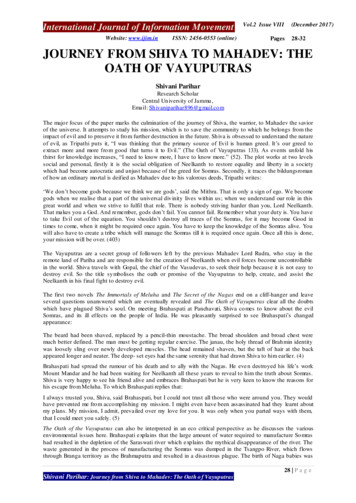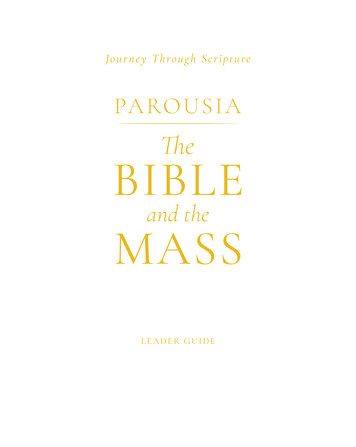
Transcription
Jo u r n e y T hrough Sc ript ureLEADER GUIDEBAM-LG-Print-V2.indd 14/12/21 1:06 PM
Copyright 2021 St. Paul Center for Biblical Theology. All rights reserved.Library of Congress Control Number: 2020952403ISBN: 978-1-64585-089-2With the exception of short excerpts used in articles and critical reviews, no part of this work may bereproduced, transmitted, or stored in any form whatsoever, printed or electronic, without the priorpermission of the publisher.Some Scripture verses contained herein are from the Catholic Edition of the Revised Standard Versionof the Bible, copyright 1965, 1966 and Revised Standard Version Bible, Ignatius Edition, Copyright 2006, by the Division of Christian Educators of the National Council of the Churches of Christin the United States of America. Used by permission. All rights reserved.English translation of the Catechism of the Catholic Church for the United States of America, copyright 1994, United States Catholic Conference, Inc. – Libreria Editrice Vaticana. English translation of theCatechism of the Catholic Church: Modifications from the Editio Typica copyright 1997, United StatesCatholic Conference, Inc. – Libreria Editrice Vaticana.Every reasonable effort has been made to determine copyright holders of excerpted materials and to securepermissions as needed. If any copyrighted materials have been inadvertently used in this work withoutproper credit being given in one form or another, please notify the St. Paul Center in writing so thatfuture printings of this work may be corrected accordingly.Writers: Mike Aquilina, Raquel LopezGraphic Design: Patty BorgmanAcknowledgements: We sincerely thank all those whose generosity of time, talent, and treasure made thisproject possible.Several of the quotations on the Eucharist in this workbook are taken from Mystery of the Altar: DailyMeditations on the Eucharist by Kenneth J. Howell and Joseph Crownwood (Emmaus Road, 2020).St. Paul Center for Biblical Theology1468 Parkview CircleSteubenville, OH 43952StPaulCenter.comBAM-LG-Print-V2.indd 24/12/21 1:06 PM
TABLE OF CONTENTSBAM-LG-Print-V2.indd 3Welcome to Journey Through Scripture4Study Components4How to Use This Leader Guide5Lesson 1Biblical Worship is Ritual and Sacrifice9Lesson 2Covenant and Communion18Lesson 3The New Testament: Document or Sacrament26Lesson 4The Mass in the Old Testament34Lesson 5The Mass in the Gospels44Lesson 6The Mass in Acts and the New Testament Letters52Lesson 7The Mass as Heaven on Earth: Hebrews and Revelation60Lesson 8A Biblical Walk Through the Liturgy of the Word70Lesson 9A Biblical Walk Through the Liturgy of the Eucharist80Lesson 10Parousia: The Real Presence and the Second Coming90Common Prayers99Image Attributions1024/12/21 1:06 PM
WelcomeWELCOME TO JOURNEY THROUGH SCRIPTUREJourney Through Scripture is the St. Paul Center’s dynamic Bible study program designed to helpordinary Catholics grow in their knowledge of Scripture while deepening their understanding ofthe riches of our faith. Distinctively Catholic, Journey Through Scripture reads the Bible from theheart of the Church, considering both the Old and New Testaments and how they work together.It’s grounded in history, yet it actively engages topics faced by today’s Catholics. More than just anordinary Bible study, it’s biblical catechesis.Parousia: The Bible and the Mass is the fifth study in the Journey Through Scripture series. In tenbeautifully produced lessons, you will learn that liturgy is not a matter of a few select verses takenin isolation. It’s a major theme that runs through the entire Bible, from Genesis to the Book ofRevelation. During this study, we’ll make stops along the way—in the Law, the Prophets, the Histories, and the Writings. We’ll see how the New Testament is concealed in the Old—and how theOld is revealed in the New.We’ll discover that all of God’s action, in creation and redemption, is ordered to communion withus in the Eucharist. The Mass is the explicit sign of his New Covenant with humankind.Study ComponentsParousia: The Bible and the Mass is designed for both group and individual study. It contains sevenpossible components, all of which can be ordered at JourneyThroughScripture.com. This Leader Guide Parousia: The Bible and the Mass Study Guide Parousia: The Bible and the Mass DVD set or video streamingThis study is based on four of Dr. Scott Hahn’s books that have Eucharistic themes and are recommended reading for the study: The Lamb’s Supper: The Mass as Heaven on Earth Letter and Spirit: From Written Text to Living Word in the Liturgy Consuming the Word: The New Testament and the Eucharist in the Early Church The Fourth Cup: Unveiling the Mystery of the Last Supper and the CrossThese books are available for purchase at JourneyThroughScripture.com.4BAM-LG-Print-V2.indd 44/12/21 1:06 PM
WelcomeHOW TO USE THIS LEADER GUIDEThis leader guide will serve as just that—your resource to guide the participants through the study,giving you step-by-step directives. This guide contains information intended only for the leader withcross-referenced pages to the study guide. The information that is not necessarily communicatedto participants is under the headingLEADER NOTE. The suggested text you can use forsharing information with participants is found under the headingLEADER SAYS.At the end of every lesson, you will see a “Going Deeper” section with suggested readings fromSacred Scripture, the Catechism of the Catholic Church, and Dr. Hahn’s titles mentioned on the previous page to enrich your study. Also included is a “praxis” section, which is a practical applicationof the content in the lesson or an exercise to practice when attending Mass.The Leader Guide includes additional pdf files to help you in the study. This includes an editableposter, bulletin announcement to promote the study, and also a Common Prayer handout for yourparticipants.TIPS FOR LEADING JOURNEY THROUGH SCRIPTUREPray: The first step when undertaking any Catholic Bible study is always prayer. Ask the Lord howHe wants to use you for this study. Who does He want you to invite? He could be simply askingyou to lead your family in the comfort of your living room or perhaps to lead a parish Bible study.Whatever the Holy Spirit is prompting you to do, pray and ask others to pray with you, for you,and for your participants.Bible study setting: Determining the setting for your study is key. A parish study is ideal to growin fellowship within your faith community. It is also conducive to a larger number of participants.Home studies, on the other hand, may present opportunities to welcome participants who wouldotherwise never attend a parish study, providing a more intimate setting. Whether the study takesplace in a parish or at home, make it convenient, comfortable, and welcoming so that people willwant to stay and participate.Consider hosting a virtual study. Many participants may find it hard to physically attend a study.With today’s technology, participants can gather virtually. Inquire about streaming options atcustomerservice@stpaulcenter.com.Marketing: To help spread the word about the study, this supplement also includes marketingmaterials. You will find editable posters as well as bulletin blurbs in the provided PDFs.Purchasing Study guides: To inquire about parish discounts or orders of twenty study guides ormore, email us at CustomerService@StPaulCenter.com. Consider shipping delivery options whenplacing your order. It helps to order study guides at least ten days before the beginning of yourstudy to ensure you receive them on time.Participants can also purchase their own study guide online. Go to JourneyThroughScripture.com.5BAM-LG-Print-V2.indd 54/12/21 1:06 PM
WelcomePreparation: Take some time before each lesson to prepare by reading through the notes so you’refamiliar with the lesson’s content. If possible, preview the video lesson and go over the summaryand review questions in advance.Preparation doesn’t just include personal preparation, though. It’s also wise to check yourequipment ahead of time to make sure everything is working smoothly before people arrive. Forhosting virtual studies, this may mean making sure your internet connection is strong, and thatyou and your participants are familiar with how you will connect with each other when doing thestudy.Small Groups: Breaking up into small groups for discussion following the video presentation isideal for large Bible study groups. The review and discussion questions at the end of each lessonprovide good material for such groups. If you are limited on time, focus on the discussion questions,as these provide the most food for thought for participants.To facilitate the small group discussions, select extroverted individuals for each of the groups.However, you want them to be facilitators, not moderators—this means keeping the conversationon track and making sure that everyone who wants to contribute can do so.Fellowship: For in-person studies, plan some social time in with each session and, if possible,include refreshments. Snacks do not need to be elaborate or expensive. There is something quasisacramental about eating together: it is a family activity and, gathered as the Church, that’s whatwe are. This also affords participants an opportunity to get to know each other, which is a veryvaluable and, in some areas, difficult-to-achieve part of parish life.Name Tags: Providing name tags is especially important for the first few sessions when people aregetting to know each other.Start on Time: This sets the tone for the study and honors those who arrive on time. Leaders areencouraged to linger after the session is over to give more introverted individuals a chance to askquestions.Bible: Encourage participants to bring a Bible to the study. Journey Through Scripture uses theRevised Standard Version Second Catholic Edition for all Scripture references that are not directlyfrom the Liturgy.6BAM-LG-Print-V2.indd 64/12/21 1:06 PM
WelcomeSample Journey Through Scripture SessionJourney Through Scripture is intended to be a very flexible study. It can be an individual study forpersonal enrichment or a faith-building exercise with friends or fellow parishioners. Below is anexample of how a typical session might run:Amount of TimeSection5 minutesOpening Prayer25–30 minutesVideo10 minutesBreak10–15 minutesReview questions (omit if running short on time)10–15 minutesDiscussion questions5 minutesReview of memory verse and “Going Deeper”1 minuteClosing prayerFrom here on, all leader information in this guide will be printed in green. All text that is printedin black is identical to what your participants see in their Study Guide (see Leader Guide–StudyGuide page cross-referencing).7BAM-LG-Print-V2.indd 74/12/21 1:06 PM
Lesson 1BIBLICAL WORSHIP ISRITUAL AND SACRIFICELEADER RESOURCESLEADER NOTEOpening Prayer and IntroductionAt the beginning of the first session, introduce yourself and then open in prayer. If you are notcomfortable praying in your own words, you can use the prayer written below. Each lesson has anopening and closing prayer written out for your use.LEADER SAYSOpening Prayer“Heavenly Father, we thank you for calling us here to study your Word and how you meant forthis Word to be read and lived out in the Sacred Liturgy. As we commence this study, we ask forthe assistance of your Holy Spirit to guide us on the way as we learn to read the Sacred Page in itsintended context, the Mass. We ask this in your Son’s name as we pray: Our Father . . .”Welcome“Welcome to our first lesson of Parousia: The Bible and the Mass. This Journey Through Scripturestudy is unique in that Dr. Hahn will be leading us throughout and demonstrating for us thebiblical roots of the Liturgy. What we will discover is that the Bible is a liturgical book! Beginningwith Genesis and culminating in the Book of Revelation, we will discover how all of God’s action,in creation and redemption, is ordered to communion with us in the Eucharist. The Mass is theexplicit sign of his New Covenant with humankind.“This study is a part of Journey Through Scripture, a Catholic Bible study series from the St. PaulCenter for Biblical Theology, an apostolate dedicated to teaching Catholics how to read SacredScripture from the heart of the Church. Though it’s focused on Catholic doctrine and teaching,everyone—Catholic or non-Catholic—is welcome. In fact, we encourage you to invite friends tocome with you.”Introduction to the Lesson Order“Before we begin the video and start the study, I want to quickly go over the basic flow for thestudy and review what’s in your study guide so that you know what to expect as we go through it.“We will always begin each lesson with an opening prayer to ask God to send us assistance fromabove to open our hearts and minds to take in the study. Here is a handout of common prayers9BAM-LG-Print-V2.indd 94/12/21 1:06 PM
Lesson 1that we will be reciting throughout the study (give Prayer handout).”“In each lesson, you’ll first see a section titled, “The Saints and Eucharist.” These are quotes fromsaints who lived Eucharistic lives and are included here for your devotional enrichment. Rightbelow, you will see the Scripture verses discussed in the lesson.“Next is the lesson’s summary, organized by the major themes covered to assist you in retaining thecontent. Participants find this helpful as it keeps them focused on viewing the lesson and not ontaking copious notes.“Each one of the videos is about 15–20 minutes long. After the video is finished, we’ll break intogroups and go over the review and discussion questions. You’ll also notice there is a suggestedmemory verse for each lesson, as well as a “Going Deeper” section. This is suggested additionalreading to enrich your study experience. The “Praxis” section is a practical application of what islearned in the lesson. Then we will close with prayer. Feel free to linger after the study to continuefellowship.Lesson Introduction“We are about ready to begin our first session. And Dr. Hahn will begin with the question hewould ask his high school friends: “Where is the Mass in the Bible?” This first lesson will set thestage for the rest of the study as we begin exploring liturgy and its significance throughout theentire Scriptures. Let’s begin.”LEADER NOTEStart video. When video is complete, refer to the next leader note.10BAM-LG-Print-V2.indd 104/12/21 1:06 PM
Lesson 1BIBLICAL WORSHIP ISRITUAL AND SACRIFICE“STHE SAINTS AND THE EUCHARISTINCE WE ARE members of Him, and are nourished by creation—and He Himself holdsthe creation, causing the sun to rise and rain to fall as he wishes—so He professed that the cupfrom creation was His very own blood. He affirmed the bread from creation to be His verybody from which our bodies grow.”– St. Irenaeus of Lyons (ca. 130–202)Scripture Verses Discussed in Lesson 1 Genesis 4:3–8 Genesis 8:20–22 Genesis 15:9–21 Exodus 12:1–2811BAM-LG-Print-V2.indd 114/12/21 1:06 PM
Lesson 1LESSON 1 SUMMARY (Study Guide pg. 8)Where is the Mass in the Bible?As a zealous Evangelical high schooler, Scott Hahn would challenge his Catholic classmates withthis question: “Where in the New Testament do you find the sacrifice of the Mass?” Not having aclear understanding of Scripture, his classmates could not refute Scott’s question and some becameconvinced that their Catholic faith had no biblical foundations.It would be years later that Scott would come to understand the true meaning of Christ’s wordsand actions in the Upper Room and on Calvary. He discovered that the Mass was everywhere inthe Bible and that the Bible was all about the Mass.Liturgy in the Old TestamentBiblical commentary by early Church Fathersguided Scott to better understand the unity ofScripture. “The New Testament is concealed inthe Old and the Old Testament is revealed inthe New” was the adage of St. Augustine.In both the Old and New Testament, theScriptures presume, prescribe, and describe theritual life of God’s people. The Bible gives boththe content and the context of the liturgy, evenas the liturgy provides our context for understanding the Scriptures.What is liturgy? Liturgy is public service orpublic work. It is the ritual public worship observed by the people of God both in the Oldand in the New Testament.In the Book of Genesis the cosmos is portrayed as a sanctuary for God’s presence, echoed laterby the characteristics of Israel’s tabernacle and Temple. The culmination of creation is when Godcreates man, namely Adam and Eve. As lord over creation, Adam is given the duties of priest ofthe sanctuary of Eden, to “till [the garden] and keep it” (Gen 2:15). These two actions, abad andshamar in Hebrew, are his main vocation. But after the Fall, worship and sacrifice change. Adam’sson Cain, filled with envy, kills his own brother Abel in the context of a ritual sacrifice.Indeed, in Genesis we see the patriarchs performing sacrifices, from Noah in an act of thanksgivingafter the flood to Abraham sealing his covenant oaths. As head of their households, fathers performpriestly duties, offering sacrifice for themselves and on behalf of their families, and passing thatduty on to their first-born sons. The patriarchs are priests, and liturgy is central to the religion theyobserve.12BAM-LG-Print-V2.indd 124/12/21 1:06 PM
Biblical Worship Is Ritual and SacrificeLiturgy is also at the heart of Israel’s Exodus from Egypt. As part of their liberation from bondage,God’s people observe the Passover ritual, which was instituted as a memorial meal to be observedby future generations. The law of Moses is itself liturgical, instructing Israel in the manner of worship, detailing even vestments and furnishings.Even entering the Promised Land requires liturgical action from the tribes of Israel. The battleof Jericho is led not by military force but by priestly action, processing around the city blowingtrumpets. Once they are settled and at rest from their enemies, God asks David’s son, Solomon, tobuild Him a house, a temple in Jerusalem where sacrifice may be offered to Him daily.When prophets begin to rage against the Temple priests, it is not because liturgy or the priesthoodis the problem. The problem, as always, is the human heart. It is liturgy done badly and dishonestly,and this is the core of Israel’s downfall.Liturgy in the New TestamentThe centrality of liturgy does not vanish with the coming of the Messiah. Jesus observes the ritualsof Israel. He goes to synagogue, makes pilgrimages, visits the Temple, and pays the Temple tax.He does not abolish liturgy but instead establishes new and more powerful rites in the sacraments,especially the Eucharist celebrated in the Upper Room in the context of a Passover. It is a memorialmeal where He is the Lamb of God, the Bread of Life, offering His flesh and blood in atonementfor sins.So too, the early Church, learning from her Lord, leads a rich liturgical life. The Acts of theApostles and other New Testament books include accounts of the Apostles observing rituals: theybaptize, break bread, anoint, and lay hands on people. They absolve sins and observe ritual meals.In the Letters to the Romans, Corinthians, and Galatians, St. Paul addresses proper etiquette formeals shared in the presence of God. The Letter to the Hebrews and the Book of Revelation aremore focused on the liturgy, portraying the Christian Church as priestly, worshipping around analtar vested for service. All the Scriptures, the Old and New Testament, were written down for thesake of ritual worship.13BAM-LG-Print-V2.indd 134/12/21 1:06 PM
Lesson 1NOTES14BAM-LG-Print-V2.indd 144/12/21 1:06 PM
Biblical Worship Is Ritual and SacrificeLEADER NOTETake a short break at the end of the video and then begin the review and discussion questions.If your group is large, break them up into appropriately sized groups (6–10 people). Explain thepurpose of the review questions (see below) and let them know how long you have set aside forthis section.Brief answers to the review questions are listed below so you can help along any group that may notbe able to answer a particular question. If you are running short on time, skip the review questionsand move on to the discussion questions.LEADER SAYS“The review questions on page 11 are exactly that: a review of the material from the video. If youwere listening closely, Scott Hahn discussed the answer to each of these questions in the lessonsegment. See if you can answer them in the lesson summary.”REVIEW QUESTIONS (Study Guide pg. 11)1. What is a liturgy?Liturgy is public work or public service.2. Give two examples of ritual sacrifice in the Old Testament.Abel’s acceptable sacrifice, Noah’s sacrifice after the flood, Abraham’s ritual sealing God’scovenant oath, the sacrifice of the Passover lamb, the sacrifices offered in the JerusalemTemple.3. What ritual actions do we see the Apostles observing in Scripture?Baptisms, breaking bread, anointing, laying hands, absolving sin.4. What unique themes do we see in both the Letter to the Hebrews and the Book ofRevelation?These two writings portray the Church as priestly and its rituals as offerings. There are altars,priests, special vestments and furnishings for ritual, and also language of atonement.15BAM-LG-Print-V2.indd 154/12/21 1:06 PM
Lesson 1LEADER NOTEOnce your participants have completed the review questions, move on to the discussion questions.Tell them how long they have to answer these and then tell them the difference between the reviewand discussion questions.LEADER SAYS“While there are specific answers to the review questions that come directly from the lesson materials in the video, the discussion questions are different. There are no right or wrong answers. Thesequestions are meant to spur a conversation between the people in the group.”DISCUSSION QUESTIONS (Study Guide pg. 12)1. Is there anything in this lesson that you have just heard for the first time? Is there anything inthis lesson that struck you?2. Why is it important for Christians to understand the meaning of Old Testament ritual andsacrifice to fully understand the Mass?3. If someone were to ask you where the Mass is in the Bible, how would you summarize whatyou’ve learned in this lesson?16BAM-LG-Print-V2.indd 164/12/21 1:06 PM
Biblical Worship Is Ritual and SacrificeLEADER NOTEMemory Verse and “Going Deeper”Before dismissing the participants, please point out the memory verse for this lesson on page 13,as well as the “Going Deeper” reading and praxis.LEADER SAYSClosing Prayer“Our Father in heaven, we give you praise because from the beginning, you show us in the act ofcreation your intention to be in communion with humanity through worship. Continue to enkindle our hearts at every Mass. Glory be to the Father . . .”“SThis Lesson’s Memory VerseO THOSE WHO received his word were baptized, and there were added that day aboutthree thousand souls. And they held steadfastly to the apostles’ teaching and fellowship, to thebreaking of the bread and to the prayers.”– Acts 2:41–42GOING DEEPERSupplemental Reading Letter and Spirit, chapters 1–2 The Fourth Cup, chapter 2PraxisThe next time you attend Mass, listen closely for liturgical and sacrificial language. If you find ithelpful, take a pad and pen to write them down.17BAM-LG-Print-V2.indd 174/12/21 1:06 PM
Lesson 2Lesson 2COVENANT ANDCOMMUNIONLEADER RESOURCESLEADER SAYSOpening Prayer“Loving Father, we thank you for once again allowing us to come together to break open yourword. We pray that it enkindles our hearts and illumines our minds to see your plan for communion with us through your New and eternal covenant. We call on the assistance of the Holy Spiritto be our guide as we pray: Come Holy Spirit . . .” (refer to “Common Prayers” handout.)LEADER SAYSLesson Introduction“Last time, if you recall, we began the study by looking at liturgy and how it is woven throughoutScripture, both in the Old and the New Testament. Feel free to review the lesson summary onpage 16 for a more detailed refresher. In this session, we’ll focus on the meaning of covenant andits relationship to liturgy. We will see how Christ fulfills all the covenants in the Old Testamentby establishing a New and everlasting Covenant in a liturgical setting for the sake of communion.LEADER NOTEStart video.18BAM-LG-Print-V2.indd 184/12/21 1:06 PM
Bible: Encourage participants to bring a Bible to the study. Journey rough Scripture uses the Revised Standard Version Second Catholic Edition for all Scripture references that are not directly from the Liturgy. BAM-LG-Print-V2.indd 6 4/12/21 1:06 PM
